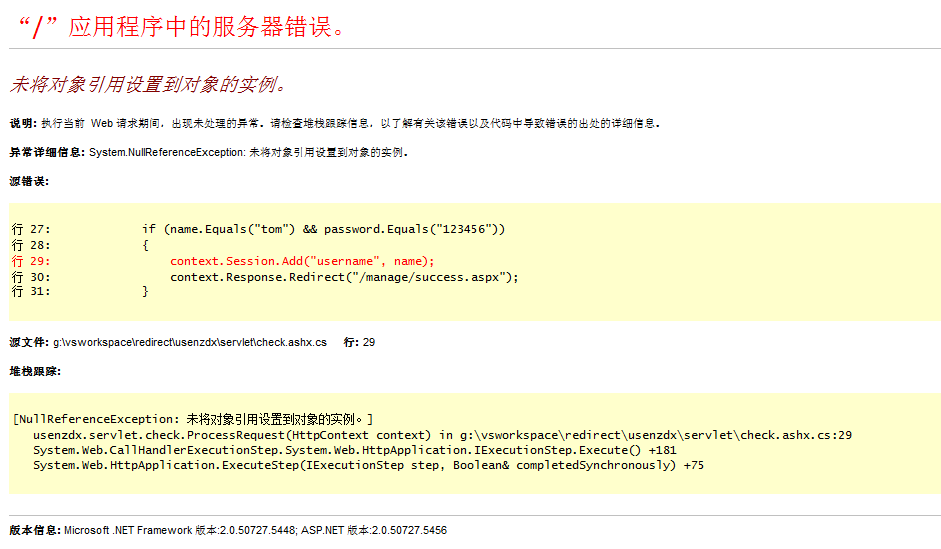ASP.NET 提供的7大内置对象:
- Response
服务器端将数据作为请求的结果发送到浏览器端(输出) - Request
浏览器端对当前页请求的访问发送到服务器端(输入) - Application 存储跨网页程序的变量或对象,中止于停止IIS服务(公用变量和对象)
- Session
存储跨网页程序的变量或对象,中止于联机离线或有效时间(单一用户对象) - Server
定义一个与Web服务器相关的类提供对服务器上方法和属性的访问 - Cookie
保存客户端浏览器请求的服务器页面,存放保留非敏感用户信息 - Cache
Web应用程序的缓存
下面的例子就来写个小程序,学习下使用最多的内置对象session和request,下面看下界面
<%@ Page Language="C#" AutoEventWireup="true" CodeBehind="index.aspx.cs" Inherits="usenzdx._Default" %>
<!DOCTYPE html PUBLIC "-//W3C//DTD XHTML 1.0 Transitional//EN" "http://www.w3.org/TR/xhtml1/DTD/xhtml1-transitional.dtd">
<html xmlns="http://www.w3.org/1999/xhtml" >
<head runat="server">
<title>无标题页</title>
</head>
<body>
<form id="Form1" runat="server" action="servlet/check.ashx" method="post">
用户名:<input type="text" name="name" id="name"/><br /><br />
密码:<input type="password" name="password" id="password"/><br /><br />
<input type="submit" value="登录"/>
</form>
</body>
</html>
下面写个一般处理程序来处理用户登录
using System;
using System.Collections;
using System.Data;
using System.Linq;
using System.Web;
using System.Web.Services;
using System.Web.Services.Protocols;
using System.Xml.Linq;
using System.Web.SessionState;
namespace usenzdx.servlet
{
/// <summary>
/// $codebehindclassname$ 的摘要说明
/// </summary>
[WebService(Namespace = "http://tempuri.org/")]
[WebServiceBinding(ConformsTo = WsiProfiles.BasicProfile1_1)]
public class check : IHttpHandler,IReadOnlySessionState
{
public void ProcessRequest(HttpContext context)
{
context.Response.ContentType = "text/html";
//取得用户名和密码
string name = context.Request["name"];
string password = context.Request["password"];
// string path1 = context.Response.Write(context.Request.MapPath());
if (name.Equals("tom") && password.Equals("123456"))
{
context.Response.Write(context.Server.MapPath("/"));
context.Response.Write("</br>");
context.Session["username"] = name;
context.Server.Transfer("/manage/success.aspx");
}
else {
context.Response.Redirect("/manage/failure.aspx");
}
}
public bool IsReusable
{
get
{
return false;
}
}
}
}
这里需要注意,首先要引入System.Web.SessionState,之后类要继承IReadOnlySessionState,否则会报下面的错误。

下面来看下运行的效果图,这里我也打印了下站点根目录
